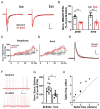Increasing endogenous activity of NMDARs on GABAergic neurons increases inhibition, alters sensory processing and prevents noise-induced tinnitus
- PMID: 32686710
- PMCID: PMC7371882
- DOI: 10.1038/s41598-020-68652-5
Increasing endogenous activity of NMDARs on GABAergic neurons increases inhibition, alters sensory processing and prevents noise-induced tinnitus
Abstract
Selective enhancement of GABAergic inhibition is thought to impact many vital brain functions and interferes with the genesis and/or progression of numerous brain disorders. Here, we show that selectively increasing NMDA receptor activity in inhibitory neurons using an NMDAR positive allosteric modulator (PAM) elevates spiking activity of inhibitory neurons in vitro and in vivo. In vivo infusion of PAM increases spontaneous and sound-evoked spiking in inhibitory and decreases spiking in excitatory neurons, and increases signal-to-noise ratio in the primary auditory cortex. In addition, PAM infusion prior to noise trauma prevents the occurrence of tinnitus and reduction in GABAergic inhibition. These results reveal that selectively enhancing endogenous NMDAR activity on the GABAergic neurons can effectively enhance inhibitory activity and alter excitatory-inhibitory balance, and may be useful for preventing diseases that involve reduced inhibition as the major cause.
Conflict of interest statement
The authors declare no competing interests.
Figures





References
Publication types
MeSH terms
Substances
LinkOut - more resources
Full Text Sources
Medical
Molecular Biology Databases
Miscellaneous

